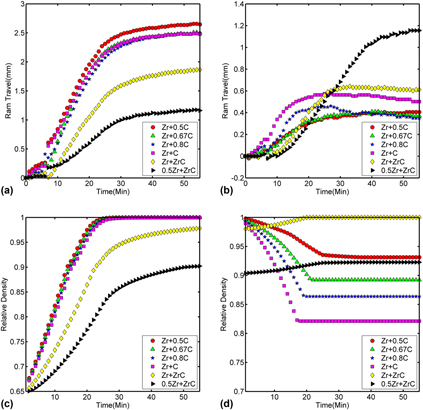Crossref Citations
This article has been cited by the following publications. This list is generated based on data provided by
Crossref.
Chakrabarti, Tamoghna
Rangaraj, Lingappa
and
Jayaram, Vikram
2016.
On the Low Temperature Densification of Reactively Hot Pressed Non-Stoichiometric ZrC and (Zr,Ti)C.
Materials Today: Proceedings,
Vol. 3,
Issue. 9,
p.
3077.
Rangaraj, Lingappa
Chakrabarti, Tamoghna
Kannan, Rajaguru
and
Jayaram, Vikram
2016.
Effect of applied pressure on densification of monolithic ZrCxceramic by reactive hot pressing.
Journal of Materials Research,
Vol. 31,
Issue. 4,
p.
506.
Fahrenholtz, William G.
and
Hilmas, Greg E.
2017.
Ultra-high temperature ceramics: Materials for extreme environments.
Scripta Materialia,
Vol. 129,
Issue. ,
p.
94.
Liu, Limeng
Hou, Zhaoping
Zhao, Yanwei
Geng, Guihong
and
Wang, Yujin
2018.
Fabrication of ZrB2 ceramics by reactive hot pressing of ZrB and B.
Journal of the American Ceramic Society,
Vol. 101,
Issue. 12,
p.
5294.
Kannan, Rajaguru
Venkateswarlu, Karodi
and
Rangaraj, Lingappa
2018.
Effect of nonstoichiometry on mechanical properties of reactive hot‐pressed monolithic ZrCx Ceramic.
International Journal of Applied Ceramic Technology,
Vol. 15,
Issue. 6,
p.
1366.
Kannan, Rajaguru
and
Rangaraj, Lingappa
2018.
Densification of ZrCx-ZrB2 Composites by Reactive Hot Pressing at Low Applied Pressure.
Metallurgical and Materials Transactions A,
Vol. 49,
Issue. 8,
p.
3539.
Shabalin, Igor L.
2019.
Ultra-High Temperature Materials II.
p.
423.
NİL, Metin
ÖZTÜRK, Yavuz
ÖZDEMİR, Sadık
SÖZEN, Hasan
and
NİL, Mustafa
2019.
OLED TV için yarım köprü LLC rezonans dönüştürücü güvenilirlik analizi.
Gazi Üniversitesi Mühendislik Mimarlık Fakültesi Dergisi,
Vol. 34,
Issue. 3,
p.
1295.
Zhou, Yue
Heitmann, Thomas W.
Bohannan, Eric
Schaeperkoetter, Joseph C.
Fahrenholtz, William G.
and
Hilmas, Gregory E.
2020.
Carbon vacancy ordering in zirconium carbide powder.
Journal of the American Ceramic Society,
Vol. 103,
Issue. 4,
p.
2891.
Kannan, Rajaguru
and
Rangaraj, Lingappa
2020.
Densification, mechanical, and tribological properties of ZrB2‐ZrCx composites produced by reactive hot pressing.
Journal of the American Ceramic Society,
Vol. 103,
Issue. 11,
p.
6120.
Kannan, Rajaguru
Rangaraj, Lingappa
and
Jayaram, Vikram
2021.
Reactive hot pressing of TiC0.5 ceramic at low applied pressure with 1 wt% Ni additive.
Journal of the American Ceramic Society,
Vol. 104,
Issue. 11,
p.
5461.
Borge-Durán, Ignacio
Aias, Denial
and
Grinberg, Ilya
2021.
Modelling of high-temperature order–disorder phase transitions of non-stoichiometric Mo2C and Ti2C from first principles.
Physical Chemistry Chemical Physics,
Vol. 23,
Issue. 39,
p.
22305.
Lun, Huilin
Zeng, Yi
Xiong, Xiang
Ye, Ziming
Zhang, Zhongwei
Li, Xingchao
Chen, Haikun
and
Liu, Yufeng
2021.
Oxidation behavior of non-stoichiometric (Zr,Hf,Ti)Cx carbide solid solution powders in air.
Journal of Advanced Ceramics,
Vol. 10,
Issue. 4,
p.
741.
Zhou, Yue
Watts, Jeremy
Li, Cheng
Fahrenholtz, William G.
and
Hilmas, Gregory E.
2023.
Vacancy ordering in zirconium carbide with different carbon contents.
Journal of the European Ceramic Society,
Vol. 43,
Issue. 14,
p.
5814.
Kochanov, G. P.
Kostikov, I. A.
Kovalev, I. A.
Kannykin, S. V.
Shevtsov, S. V.
Konovalov, A. A.
Osipov, P. A.
Kostyuchenko, A. V.
Klimaev, S. N.
Strel’nikova, S. S.
Chernyavskii, A. S.
and
Solntsev, K. A.
2023.
Preparation of Zirconium Carbide-Based Refractory Ceramics by Direct Zirconium Carburization.
Inorganic Materials,
Vol. 59,
Issue. 2,
p.
196.
Rangaraj, Lingappa
2024.
Reactive hot pressing parameters on reaction, densification, and mechanical properties of Ti3AlC2 ceramic.
International Journal of Applied Ceramic Technology,
Vol. 21,
Issue. 1,
p.
44.





